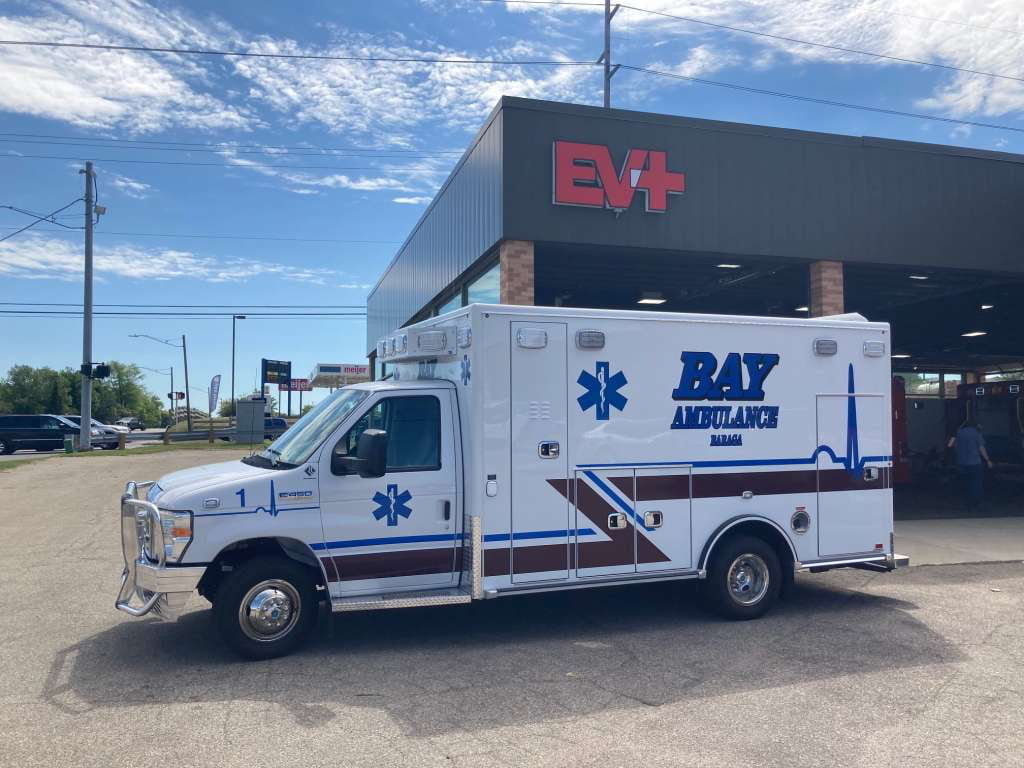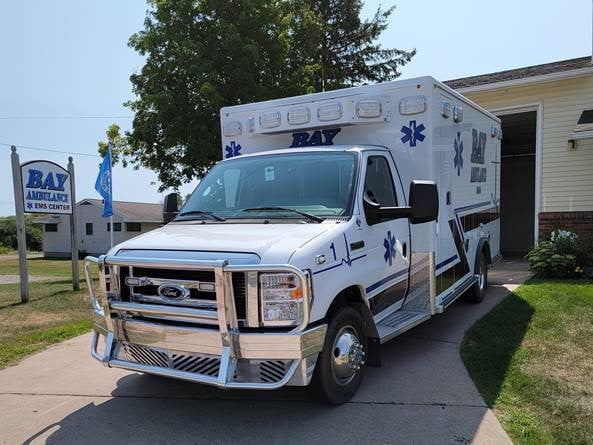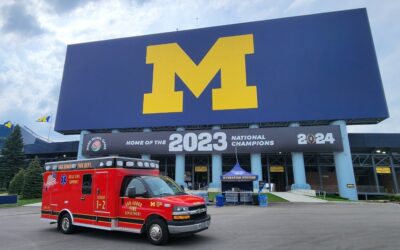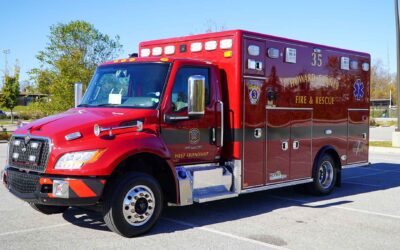
Road Rescue built this Type 3 ambulance on a Ford E-450 chassis with an UltraMedic walk-through body that has a 168-inch long wheelbase. (Photos courtesy of Emergency Vehicles Plus)
By Alan M. Petrillo
Bay Ambulance, a non-profit EMS organization located on the south shore of Lake Superior that serves seven townships in Baraga County in Yupper Michigan, had Road Rescue build it a new Type 3 ambulance to replace an older rig in its four-ambulance fleet.
Related
American Emergency Vehicles Delivers Type 3 Ambulance to Somerset (PA) Area Ambulance Association
Needham (MA) Fire Department Gets Horton Type 1 Ambulance
Horton Builds Ambulance for Upper Township (NJ) Division of EMS
Mackinac Island (MI) EMS Gets Custom Wheeled Coach Ambulance
Gary Wadaga, director of Bay Ambulance, says his department covers a population base of about 9,000 persons in 1,500 square miles of mostly rural area from a single station with four full time paid paramedics, and 35 volunteer emergency medical technicians (EMT). “We run a thousand calls a year, with a third of those calls being interfacility transfers,” Wadaga points out. “We serve a 12-bed critical access hospital with emergency room services, but major trauma, surgical and orthopedic cases have to be transferred 55 miles to a regional medical center in Marquette. The typical response and transport time for our four ALS (advanced life support) ambulances is between 35 and 40 minutes, and the average trip is 70 miles one way.”

The Road Rescue rig built for Bay Ambulance has a heavy duty Ali Arc Industries bumper guard on the front of the vehicle for wayward moose and deer.
The new ambulance that Road Rescue built for Bay Ambulance is on a Ford E-450 chassis with an UltraMedic walk-through body, says Scott Schalow, ambulance sales manager for Emergency Vehicles Plus, who sold the Road Rescue rig to Bay Ambulance. Wheelbase on the ambulance is 158 inches, while the patient module is 96 inches wide, 168 inches long, and 98 inches high, with 72 inches of inside headroom.
Wadaga says his department has always liked Road Rescue products because of their quality, safety features and service capabilities. “Besides our new 2021 Road Rescue Type 3, we also have a 2012 Road Rescue Type 3 on a Chevy chassis, a 2000 Road Rescue Type 3 on a Ford F-350 chassis, and a 2003 McCoy Miller four-wheel drive Type 3 on a Ford F-350 chassis, all of which are equipped with trailer hitches to tow an 18-foot trailer that holds a utility terrain vehicle (UTV) with Mattracks and an enclosed snow sled for winter rescues,” he notes.

Bay Ambulance’s new rig has a Stryker Power-LOAD and Power-Pro XT cot in the patient module.
Bay Ambulance is concerned about the safety of its medics and patients in the back of the rig, Wadaga points out, which is a chief reason why the department chose a Road Rescue product. “On our new rig, we have the Per4max four-point seat harness restraints on all seating positions, a Stryker Power-LOAD and Power-Pro XT cot, a Zico O2 bottle lift system, a LIFEPAK 15 defibrillator bracket mounted to the cabinetry, a patient compartment camera that transmits to the driver, all reflectorized graphics and chevrons, and a heavy duty Ali Arc Industries bumper guard on the front of the vehicle for wayward moose and deer,” he says. “Also we had Road Rescue set up the interior cabinetry similar to what we have on our other ambulances so when medics and EMTs are jumping from one ambulance to another there’s a continuity to where the equipment is located,” he says.
Schalow adds that the camera in the patient module is a Safety Vision model that allows the driver to monitor what’s happening in the back of the rig. “The camera also has a microphone built into it so the driver can hear what’s being said back there, which is another safety feature,” he says. “The ambulance also has a Safety Vision backup camera.”
He points out that when exterior cabinet doors are open they show red and white safety stripes at their top, and that the ambulance has lower rub rail lighting. “When the ambulance’s warning lights are on the rub rail lighting flashes red and white, but once the vehicle is in park at a scene, the flashing stops and the white lights come on steadily to serve as ground lighting around both sides of the rig and across the back.”
ALAN M. PETRILLO is a Tucson, Ariz.-based journalist, the author of three novels and five non-fiction books, and a member of the Fire Apparatus & Emergency Equipment editorial advisory board. He served 22 years with Verdoy (NY) Fire Department, including the position of chief.




